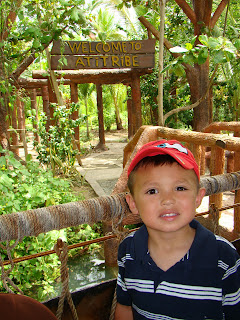Tuesday, July 6, 2010


 Three legends explain the formation of the Chocolate Hills. The first tells the story of two feuding giants who hurled rocks, boulders and sand at each other. The fighting lasted for days, and exhausted the two giants. In their exhaustion, they forgot about their feud and became friends, but when they left they forgot to clean up the mess they had made during their battle, hence the Chocolate Hills.
Three legends explain the formation of the Chocolate Hills. The first tells the story of two feuding giants who hurled rocks, boulders and sand at each other. The fighting lasted for days, and exhausted the two giants. In their exhaustion, they forgot about their feud and became friends, but when they left they forgot to clean up the mess they had made during their battle, hence the Chocolate Hills.A more romantic legend tells of a giant named Arogo who was extremely powerful and youthful. Arogo fell in love with Aloya who was a simple mortal. Aloya's death caused Arogo much pain and misery, and in his sorrow he could not stop crying. When his tears dried the Chocolate Hills were formed.
The third legend tells of a town being plagued by a giant carabao, who ate all of their crops. Finally having had enough, the townsfolk took all of their spoiled food and placed it in such a way that the carabao would not miss it. Sure enough, the carabao ate it, but his stomach couldn't handle the spoiled food, so he defecated, leaving behind him a mound of feces, until he had emptied his stomach of the food. The feces then dried, forming the Chocolate Hills.
2. Simply Butterflies Conservation Center
 Simply Butterflies Conservation Center is the first butterfly livelihood breeding and conservation program in Bohol. Its main goal is to protect and strengthen the natural environment of the butterflies through plant research, breeding and releasing.
Simply Butterflies Conservation Center is the first butterfly livelihood breeding and conservation program in Bohol. Its main goal is to protect and strengthen the natural environment of the butterflies through plant research, breeding and releasing.

3. The Man-Made Forest in Bohol
 The man-made forest stands out because of the uniformity in height of the big trees, the spread of its branches, thickness and design of leaves. Seedlings abound around the older trees. Trunks, some thick and others just a few months old, grow resplendently straight up towards the sky which is obscured by the branches and the thick leaves.
The man-made forest stands out because of the uniformity in height of the big trees, the spread of its branches, thickness and design of leaves. Seedlings abound around the older trees. Trunks, some thick and others just a few months old, grow resplendently straight up towards the sky which is obscured by the branches and the thick leaves. The terrain from both side of the road goes up; to I don’t know how high. What you see are only the Mahogany trees that look like thousands of sentinels guarding the road, standing erect. No other vegetation is growing among the Mahogany trees. One only sees the brown trunks stretching forth from the earth and the green canopy above. And that’s what makes them look so attractive!
The terrain from both side of the road goes up; to I don’t know how high. What you see are only the Mahogany trees that look like thousands of sentinels guarding the road, standing erect. No other vegetation is growing among the Mahogany trees. One only sees the brown trunks stretching forth from the earth and the green canopy above. And that’s what makes them look so attractive! 






This bridge hangs approximately 20 meters above the Loboc River and sways back and forth as you walk across.

















The Philippine Tarsier (Tarsius syrichta), known locally as the Maumag in Cebuano/Visayan, is an endangered tarsier species endemic to the Philippines. It is found in the southeastern part of the archipelago, particularly in the islands of Bohol, Samar, Leyte, and Mindanao. Its name is derived from its elongated "tarsus" or ankle bone.
Its geographic range also includes Maripipi Island, Siargao Island, Basilan Island and Dinagat Island. Tarsiers have also been reported in Sarangani, although they may be different subspecies. Being a member of a family that is about 45 million years old, it was only introduced to western biologists in the 18th century.

 The Philippine Tarsier is a tiny animal, measuring about 4 to 6 inches (15 cm) in height. The small size makes it difficult to spot. The average mass for males is around 134 grams, and for females, around 117 grams. The average adult is about the size of a human fist and will fit very comfortably in the human hand.
The Philippine Tarsier is a tiny animal, measuring about 4 to 6 inches (15 cm) in height. The small size makes it difficult to spot. The average mass for males is around 134 grams, and for females, around 117 grams. The average adult is about the size of a human fist and will fit very comfortably in the human hand. Like all tarsiers, the Philippine Tarsier's eyes are fixed in its skull; they cannot turn in their sockets. Instead, a special adaptation in the neck allows its round head to be rotated 180 degrees. The large membranous ears are mobile, appearing to be almost constantly moving, allowing the tarsier to hear any movement. It has uniquely large eyes (disproportionate to its head and body), which are listed in the Guinness Book of Records as the largest eyes on any mammal. These huge eyes provide this nocturnal animal with excellent night vision.
Like all tarsiers, the Philippine Tarsier's eyes are fixed in its skull; they cannot turn in their sockets. Instead, a special adaptation in the neck allows its round head to be rotated 180 degrees. The large membranous ears are mobile, appearing to be almost constantly moving, allowing the tarsier to hear any movement. It has uniquely large eyes (disproportionate to its head and body), which are listed in the Guinness Book of Records as the largest eyes on any mammal. These huge eyes provide this nocturnal animal with excellent night vision. The Philippine Tarsier has thick and silky fur which is colored gray to dark brown. The thin tail, usually used for balance, is naked or bald except for a tuft of hair at the end, and is about twice the body length. Its elongated "tarsus," or ankle bone, which gives the tarsier its name, allows it to jump at least three meters from tree to tree without having to touch the ground. Its long digits are tipped with rounded pads that allow T. syrichta to cling easily to trees and to grip almost any surface. The thumb is not truly opposable, but the first toe is. All of the digits have flattened nails, except for the second and third toes, which have sharp claws specialized for grooming.
The Philippine Tarsier has thick and silky fur which is colored gray to dark brown. The thin tail, usually used for balance, is naked or bald except for a tuft of hair at the end, and is about twice the body length. Its elongated "tarsus," or ankle bone, which gives the tarsier its name, allows it to jump at least three meters from tree to tree without having to touch the ground. Its long digits are tipped with rounded pads that allow T. syrichta to cling easily to trees and to grip almost any surface. The thumb is not truly opposable, but the first toe is. All of the digits have flattened nails, except for the second and third toes, which have sharp claws specialized for grooming. The dental formula is 2:1:3:3 in the upper jaw and 1:1:3:3 in the lower jaw, with relatively small upper canines.
 An interesting boat ride along the Loboc River has been a major attraction, both foreign and domestic. Starting from Loboc Tourism Complex, Floating Restaurants and motorized boats start the thrilling boat ride along palm-fringed banks inland.
An interesting boat ride along the Loboc River has been a major attraction, both foreign and domestic. Starting from Loboc Tourism Complex, Floating Restaurants and motorized boats start the thrilling boat ride along palm-fringed banks inland. Loboc is a 5th class municipality in the province of Bohol, Philippines. It is mere 24 km away from Tagbilaran City, the provincial capital of Bohol.
Loboc is known for its floating restaurants along the scenic and winding Loboc River. Tourists also come to see the tarsier, a small nocturnal animal with large eyes. It is one of the world's smallest primates. Unfortunately, the tarsiers here are kept in an inadequate cage, and better be observed in the Tarsier Sanctuary in Corella.
 This was on the top of my favorite list that day. With the yummy food and entertainment, the Loboc River Cruise made my day! (We did the tour on my birthday)
This was on the top of my favorite list that day. With the yummy food and entertainment, the Loboc River Cruise made my day! (We did the tour on my birthday)
 During the cruise we stopped at the AtiTribe. It was fun meeting the members of their tribe. You can see more pictures of us with them in the slide show.
During the cruise we stopped at the AtiTribe. It was fun meeting the members of their tribe. You can see more pictures of us with them in the slide show.
7. Prony: World's Largest Python in Captivity
Despite his enormous size, Prony is practically “harmless” that anybody who enters in his specially-made steel cage—accompanied by the statuesque owner and caretaker, Jing “Python Lady” Salibay—is out of harm's way.



The Baclayon Church is the oldest Catholic stone church building in the Philippines. It was constructed during the Spanish occupation and the first Spanish missionaries (called doctrineros) settled in the area in the late 15th century. Today you can still see the original stone structure of the Baclayon Church in the City of Tagbilaran, Bohol, Philippines.
There are other preserved church buildings in the region but the Baclayon Church is the best preserved among them. The church itself is Jesuit, but the Baclayon Church (the one we see today) was completed in 1727. The erectedchurch building known today as the Baclayon Church is formally known as The Church of Our Lady of the Immaculate Conception.


 9. BLOOD COMPACT
9. BLOOD COMPACTThe Sandugo was a blood compact, performed in the island of Bohol in the Philippines, between the Spanish explorer Miguel López de Legazpi and Datu Sikatuna the chieftain of Bohol on March 16, 1565, to seal their friendship as part of the tribal tradition. This is considered as the first treaty of friendship between the Spaniards and Filipinos. "Sandugo" is a Visayan word which means "one blood".
The Sandugo is depicted in both the provincial flag and the official seal of the government in Bohol. It also features the image of the blood compact. The top of the seal explains the history behind the Sandugo event that occurred in Bohol, the fleet and the location where the Spaniards anchored and the place where the treaty was conducted which was dated on March 16, 1565.







 When we were done with the tour, we went back to the port to catch the last trip to Cebu. We had an amazing experience of our Bohol Tour...
When we were done with the tour, we went back to the port to catch the last trip to Cebu. We had an amazing experience of our Bohol Tour...
























